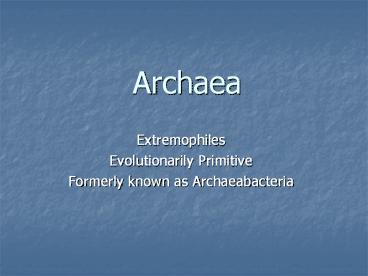Archaea - PowerPoint PPT Presentation
1 / 26
Title: Archaea
1
Archaea
- Extremophiles
- Evolutionarily Primitive
- Formerly known as Archaeabacteria
2
History
- Originally grouped with Bacteria
- Recognized in 1977
- Carl Woese and George Fox
- 16S rRNA sequencing
- Greek archaea ancient
- Common ancestor thought to be a simplistic
prokarya with poorly organized genetic material - Thought to be involved in evolution of
Eukarya-not accepted
3
Morphology
- Spherical, rod-shaped, spiral, lobed,
filamentous, or rectangular
4
Morphology
- 0.1-15 microns
- Single circular chromosome
- Single cell membrane
- Flagella
- No organelles
5
Ecology
- Extremophiles (coined 1974)
- Thermophiles (up to 113C)
- Black smokers
- Geysers
- Psycrophiles
- Acidophiles and Alkaliphiles
- Halophiles
- Some combine extremes, ie Picrophilus (60C and
0.5pH) - Methanogens
- Often found in the guts of ruminants, termites
and even humans - Found in all known environments
6
Adaptations to Extremes
- In extreme pH must avoid hydrolysis of
proteins-achieved by changing internal pH - Anaerobes do not maintain stasis, while aerobes
do - Specific enzymes are active at optimal pH
- Structure of cell membrane stabilized in high
temperature environments by - Allows for formation of carbon rings which
increases stability - Ether linkage is less reactive than ester linkage
- Tetraether molecules
- Can form monolayers (Sulfolobus and Thermoplasma)
7
Adaptations to Extremes
- Protection of genetic material
- High salt concentrations in cytoplasm
- DNA binding proteins similar to eukaryotic
histones - Share amino acid homology
- MC1-Methanosarcinaceae
- HMf-Methanobacteriales
- Organizes DNA in sturctures similar to chromatin
- Allows for positive supercoiling
- Eukarya have negative supercoiling (nucleosome)
- HTa-Thermoplasma
- HTa (like)-Sulfolobus
8
Evolution
- Primitive form
- Related to Eukarya
- tRNA
- Ribosomes
- TATA binding proteins and TFIIB (transcription)
- Similar initiation and elongation factors for
translation - Similarities to bacterial genetic material
9
Evolution
10
Phyla
- Based on rRNA sequences
- Originally two groups
- Currently three recognized
- Crenarchaeota
- Euryarchaeota
- Korarchaeota
11
Crenarchaeota
- Rod, spherical, filamentous, and oddly shaped
cells - Organotrophic and lithotrophic
- Most are anaerobes
- Lack histone like proteins
- Some sulfur dependent (as electron acceptor or
donor) - Thermophiles (82-110 Celcius up to 113C known)
- Thermoacidophiles
- Psycrophiles
- Discovered when lipids of composition similar to
other archaea were found in ocean water - Could be a major contributor to global carbon
fixation - Genera
- Sulfolobus, Desulfurococcus, Pyrodictium,
Thermoproteus, Thermofilum
12
Euryarchaeota
- Broad ecological range
- Thermophilic aerobes and anaerobes
- Pyrococcus and Thermococcus S-metabolizers
- Extreme Thermophilic
- Sulfate reducing archaea
- Thermoplasms
- Halobacteria
- Methanogens
13
Euryarchaeota
- Extreme Thermophilic S-metabolizers
- Thermococci (anaerobic)
- Reduce sulfur to sulfide
- Flagellated
- (80-100 Celcius)
- Archaeoglobi
- Sulfate reducing archaea
- Sulfate, sulfite, thyosulfate into sulfide
- Thermophilic
- Including marine thermal vents
- Has cell wall with glycoprotein subunits
- Gram negative
14
Euryarchaeota
- Thermoplasms
- Thermoacidophiles that lack cell walls
- Cell membrane strengthened by various proteins
- 55-59 Celcius at pH 1-2
- May be aerobic
- May be flagellated
- Mine refuse piles
15
Euryarchaeota
- Halobacteria
- Halobacterium and Haloferax
- Dependent on high salt concentrations
- Aerobic
- Some flagellated
- Chemoherterotrophs with respiratory metabolism
- Some use light to form ATP (not photosynthesis-no
chlorophyl) - Rhodopsin (4 types)
16
Euryarchaeota
- Methanogens
- Methanosarcina
- Themophilic varietes (84-110 Celcius) including
Methanobacterium, Methanococcus, Methanothermus - Anaerobics
- Convert carbon dioxide, hydrogen gas, menthanol,
acetate to methane (and carbon dioxide) for
energy - Autotrophic
- Survive in conditions similar to those of a young
Earth
17
Korarchaeota
- Recently discovered in terrestrial geysers
- Yellowstone
- Separation supported by 16S rRNA sequencing
- Evolutionary divergence from within Crenarchaeota
or from before divergence of Crenarchaeota and
Euryarchaeota
18
Unique characteristics of Archaea
- Cell membrane
- Single layer
- Pseudopeptidoglycan or protein
- L-glycerol (stereoisomer)
- Ether linkage (C-20 diether lipids)
- Some tetraether molecules (C-40 tetraether
lipids) - Branching hydrophobic side chain
- Carbon ring formation
- Resistant to lysozyme and beta-lactam antibiotics
- Flagella have unique composition and development
19
Cell Membrane
20
Unique Characteristics
- Metabolic differences
- ADP dependent kinase (not ATP)
- Pyrophosphate-linked kinases (not pyrophosphate
dependent phosphofructokinases) - Organotrophs, autotrophs, and an unusual form of
photosynthesis - No Archaea uses the full respiration or
photosynthetic cycles, but instead employs many
of the steps individually - Methanogens and some extreme thermophiles use
glycogen instead of glucose
21
Unique Characteristics
- Intracellular bodies
- rRNA (16S) sequence
- tRNA
- Plasmids
- Lack of organelles (similar to bacteria)
22
Unique Characteristics
- Genetic Material
- Resistance to denaturation by heat seen in
thermophiles - Similar structure to bacteria
- Some sequencing has revealed sections of DNA that
are shared with bacteria (gene sharing between
bacteria and archaea?) - Primary protein sequence is similar to Eukarya
- Genes with similar functions organized together
(similar to operons) - Introns are found in rRNA and tRNA genes
23
Unique Characteristics
- Replication
- DNA Polymerase similar to that of eukaryotes,
eukaryal virues and E. coli - 3-5 exonuclease (proofreading)
- Restriction endonuclease
- Topoisomerase
- Gyrase
- Halobacterium halobium has reverse transcriptase
24
Unique Characteristics
- Transcription
- RNA polymerase has up to 14 subunits (E. coli has
only 4) and is similar to eukaryotes - Requires general transcription factors to
initiate (like eukarya) - Promoters have an A-T rich sequence similar to
eukarya TATA box - Translation
- Signals similar to bacteria
25
Ending on a historical note re-enactment
of the separation of archaea from bacteria
26
Sources
- Brown, J. R. and Doolittle, W. F. 1997. Archaea
and the Prokaryote-to-Eukaryote Transition.
Microbiology and Molecular Biology Reviews. 61
(4) 456-502. - Griffith University-http//trishul.sci.gu.edu.au/
- Kevbrin, V. V., Romanek, C. S., Wiegel, J.
Alkalithermophiles A Double Challenge from
Extreme Environments. - Microbiology 6th ed.
- University of California Berkley-www.ucmp.berkeley
.edu/archaea/archaea.html

